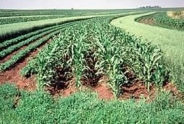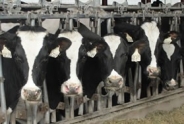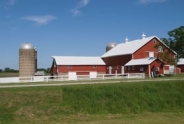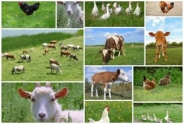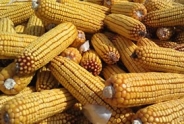Managing Flood Damaged Crops
Prepared by Greg Roth, Jud Heinrichs, Craig Altemose, Virginia Ishler and Marvin Hall, Departments of Crop and Soil Sciences and Dairy and Animal Science; Penn State Extension

- Affected fields will contain a lot of debris and plants will have a lot of soil on them.
- Conditions will be dusty and dirty during harvest.
- Farmers can experience extra costs from wear on shear bars, knives and bearings. The silage made from flood damaged fields can range from acceptable to black or rotten.
- Decreased milk production and performance is likely when flood damaged crops are fed.
If fields sustain flooding and significant damage, contact the crop insurance adjuster to document the loss before taking action to remedy the situation. Consider contacting the local FSA office to report losses as well.
Below are some recommendations and observations that may help in making harvesting and marketing decisions.
Corn for Silage- Corn destined for silage will be more at risk for fungal and bacterial contamination. Take steps to promote good fermentation, such as heavy inoculation and extra packing in the silos. A good fermentation will kill many (but not necessarily all) pathogens in the silage.
- Target the least affected fields for silage and harvest above the silt line to avoid soil contamination.
- Avoid chopping corn for silage that has considerable dirt or silt on it.
- Segregate any corn chopped for silage so that it can be evaluated before feeding. Forage should be tested before feeding, paying particular attention to dry matter percent, starch, ash, mycotoxins and fermentation profile.
- Silage and high moisture corn from these fields should be evaluated at feed-out and animal health should be closely monitored. Soil contamination alone may not be a serious animal health factor, but contamination from manure, sewage treatment plants and other chemicals is unknown and could vary from one situation to another.
- In all cases try to minimize the soil contamination and during feed-out, attempt to dilute these forages with normal quality forages as much as possible.
- Soil and organic matter on forage crops can also lead to fermentation issues, increased ash, decreased digestibility, and animal health problems, especially for horses.
- Avoid pasturing or harvesting silt laden forage crops if at all possible.
- If pastures are grazed, don't allow the animals to graze the plants too close to the ground because the majority of the contamination will be in that area of the plant.
- It might be best to mow the previously flooded pastures and wait for them to regrow before grazing.
- Mowed forage that has been lying in the field for more than one week should simply be chopped and blown back onto the field, particularly if it is showing signs of molding (forage is slimy).
- Roots in soil flooded for 2 to 3 weeks may die from suffocation (no oxygen available for the roots to respire).
- Root diseases such as Rhizoctonia or Phyotphtora can increase in wet soils and lead to thinned stands next year.
- Avoid pasturing or harvesting silt laden forage crops if at all possible.
- Harvesting for grain is likely a better option than for silage where flooding has occurred.
- Combine air filters likely will need to be changed more frequently. Operators should take steps to avoid breathing the dust.
- Harvest when the fodder is dry to help limit the dirt in the grain. Monitor the dirt in the corn coming into the bin and avoid the worst sections of fields.
- Harvesting high-moisture corn at the drier range of acceptable levels could improve the ability to clean dirt from the corn.
- The expected quality of grain is uncertain and should be monitored. The potential for crop contamination by flood waters could affect the marketability of grain and silage. Check with grain brokers for more information on marketability as it becomes available.
- Monitor for sprouting. Some river bottom fields are prone to bird damage and often have some sprouting risk. The flood may exacerbate the problem. Try to adjust the combine to remove most of the sprouted grain.
- Monitor for molds. Corn from flood-damaged fields should be evaluated for grain quality and kept separate if there are indications of molds. Mold and mycotoxin levels can be determined by most feed testing laboratories and used as guidance in marketing.
- The risk of molds and sprouting is likely a function of the exposure to the water and stage of growth. Corn that was under water will have an increased risk for molds and bacterial rotting. This may be more pronounced in corn that was already drying down (<40% grain moisture) and then took on moisture during the flood.
- Monitor for bacterial stalk rots. Fields that remained flooded for more than 12 hours are most at risk for stalk rots.
- The crop may mature more rapidly under these conditions, since corn that has been stressed when near maturity often seems to dry down fast.
- If the grain is deemed unfit for animal use, then it will be necessary to pursue crop insurance claims. If producers expect a claim, they should consult with an adjuster prior to harvest.
- Soybean crops likely will experience increased harvest losses and increased machinery problems during harvest. Many soybeans may be impossible to harvest due to lodging and debris. Monitor grain quality prior to harvest.

Soybeans damaged by floods may not recover in late season (J. Craig Williams, Penn State).
In summary, flood-damaged crops are at risk for quality and harvest losses, but by monitoring and managing carefully, we may be able to salvage some of them, reduce losses and obtain resources for recovering from the situation.
Upcoming Events
Crops, Cows & Critters - Southwest New York Dairy, Livestock & Field Crops Newsletter Sponsorship
December 19, 2025
Our two forms of publications feature research-based and timely information from our four specialists, listed to the right, along with local event notifications and Cornell University outreach. This information is provided to participants who range from dairy, livestock, and field crops producers to agricultural suppliers and consultants.
Weekly Email Update: Shared with 625+ households who have signed up with our program.
Monthly Paper Mailer: To reach our stakeholders and farmers who lack internet access, we send out a monthly mailer where your company's logo and contact information would be featured with a mailing list of 330+ households.
If you sponsor our weekly and monthly publications you reach approximately 955 households.
Visit our website to view our newsletters!
2025 Cornell Food Beverage & Animal Feed Manufacturer Survey
December 19, 2025
Industry and Educational Advocates for New York State's Food, Beverage, and Animal Feed Manufacturing industries:
As you know, NYS has a diverse food and beverage manufacturing industry, in both the types of industries that exist and the wide distribution of firms by scale. Many manufacturing firms have strong backward linkages to agricultural production sectors in the state that support both farm-level and downstream food industry firms and consumers. In collaboration with the New York State Department of Agriculture and Markets, a team from Cornell University's Charles H. Dyson School of Applied Economics and Management has recently rolled out the 2025 New York State Food, Beverage, and Animal Feed Manufacturer Survey. The industry will benefit from an updated assessment of the industry that informs private and public investments and opportunities to support firm growth and improved profitability.
Cornell Organic Field Crops & Dairy Conference
March 6, 2026
Waterloo, NY
Farmers, researchers, educators, and agricultural service providers from across the Northeast are invited to the 2026 Cornell Organic Field Crops & Dairy Conference, held Friday, March 6, 2026, from 8:00 a.m. to 4:30 p.m. at the Lux Hotel & Conference Center in Waterloo, N.Y.
Co-hosted by New York Soil Health and Cornell CALS, the annual conference brings together leaders in organic grain, dairy, and livestock systems to share practical tools, new research, and farmer-tested strategies to support resilient and profitable organic production.
Announcements
No announcements at this time.

